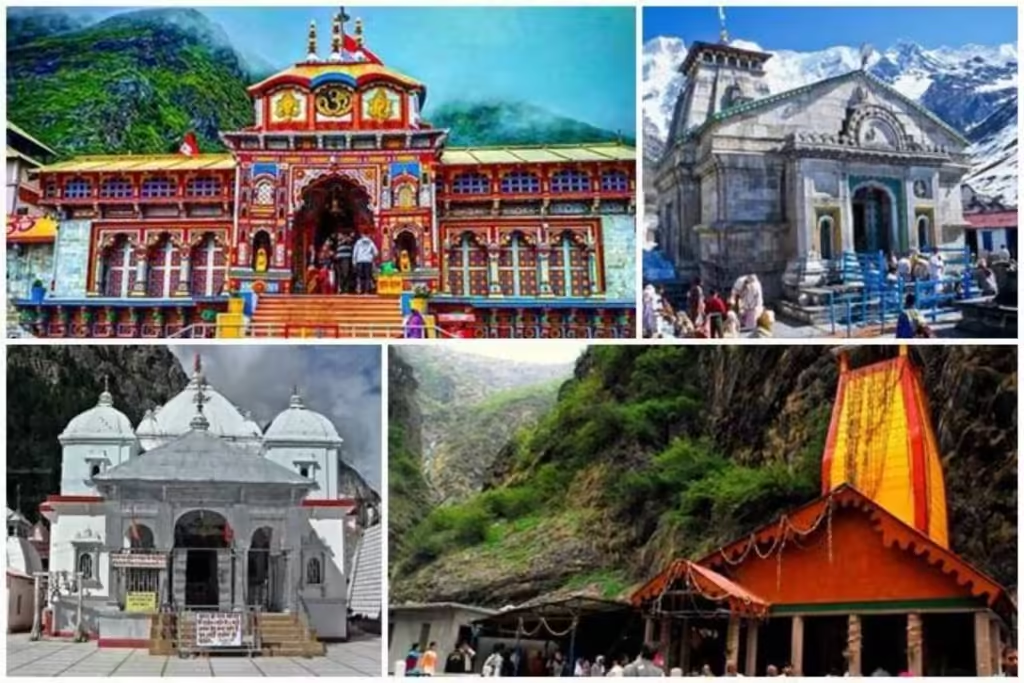Char Dham Yatra -Yoga of Faith and Spirit
The Char Dham Yatra is an immensely spiritual journey of several million Hindu devotees from all over the world. Called Char Dham Yatra, this expedition that covers the four sacred pilgrimage Places in the region of Badrinath, Kedarnath, Gangotri and Yamunotri is more than just a journey from one place to another; it takes you deep into what Hindu mythology represents – its culture & spiritual roots.

Mythological importance of Char Dham Places
The significance of the Char Dham pilgrimage is also greatly enhanced by a legends
in mythology and provides immense allure to pilgrims.
Badrinath: Badrinath is dedicated to Lord Vishnu and it is believed that this one of
the Places where divine couple Shri Vishnu performed penance. The temple is
significant as one of the Char Dham (four seats) in India, and also particularly for
being named after the wild berry that grows abundantly at this place. It belongs to a
period not later than medieval or probably earlier but no history records can justify its
origin solely taking into account religious sanctity coupled with historical antecedents
attached to it deserves due recognition worth paying tributes and respects by way of
worshipping there in.
Kedarnath is also another abode of Lord Shiva and is associated with the legendary story of Mahabharata related to Pandeva’s. As it is believed that Pandeva’s came here to meet Lord Shiva in the form of Bull with his front remaining at Pashupatinath Temple and all over his body engraved underground giving rise to Jyotirlinga, as per Mahabhrata this was done after Kurukshetra war. Gangotri, which is the origin of holy river Ganga, also reminds us a story from epic time linked with King Bhagirath who after doing penance 5500 years ago brought Ganga ji on earth to relieve ashes of IV dead ancestors. Yamunotri is dedicated to Goddess Yamuna who happened to be Lord Yama’s (Lord of death) sister. Devotees from all over the world believe that taking a bath in Yamuna river purify their selves from various sins and help attain Moksha.

Importance of Char Dham Yatra
Besides being a religious journey, the Char Dham Yatra is also a cultural occasion of
unifying various classes of people from different spaces who feel like they belong
together. It’s for this reason that pilgrims go through the yatra disregarding caste, creed
or geography thus illustrating how much Hinduism embraces all people equally.
The
actual trek forms a major section of this more comprehensive cultural experience since
devotees encounter local customs, different dishes and traditions along the way. This
way the rituals done in each Char Dham site such as prayers, pujas and taking holy dips
have huge socio‐cultural importance thus forming part of the pilgrimage
Moreover, the Char Dham Yatra plays an important role in the local economies of the
regions it passes through. The pilgrimage season brings many pilgrims who provide
opportunities for local businesses, transport services and hotels. The Spiritual Journey of the Char Dham Yatra Char Dham Yatra is not a mere physical travel but also a spiritual exploration where pilgrims aim at connecting with God and getting peace within themselves. It is believed that those who encounter hardships during their pilgrimage like climbing steep mountains or trekking long distances are likely to get spiritually empowered than those who enjoy an easy trip. The rituals performed at every Char Dham site such as pujas, prayers and taking holy dips help cleanse one’s soul and prepare him/her for salvation journey. Pradakshina signifies human life with the divine in its center around temples. While the Char Dham Yatra is a holy tradition, it has its own set of challenges. The rising number of devotees pose threats to the vulnerable ecosystems in the Himalayas. Deforestation, waste disposal as well as building huts and roads raising their voices against long-term pilgrimage sustainability. To uphold traditional cultures in harmony with nature, there are measures being put in place to protect pristine Himalayan regions where Char Dham Yatra is observed despite high influxes of tourists. Some governments and organizations have taken steps like regulating pilgrim numbers, implementing conservation strategies for mountainsides and riversides, etc.

Conclusion
The Char Dham Yatra is an affirmation of faith’s everlasting vigor as well as man’s spirit. A holy journey, drenched in myths and cultural practices, this pilgrimage still motivates many devotees around the world to travel along their path of self-discovery through enlightenment. As we face trials and tribulations of today’s world, Char Dham Yatra reminds us how vital it is to go back to our roots where we are able to achieve inner peace through our religions. By protecting the sanctity of this pilgrimage and advocating for eco-friendly practices, we can ensure that Char Dham Yatra remains a powerful wellspring of motivation and spiritual satisfaction for future generations.

